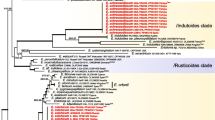Abstract
Filamentous microorganisms were observed colonizing the cuticle of cyathostomes (Nematoda: Strongylidae) collected from the large intestine of Burchell's zebra (Equus burchelli antiquorum). Scanning (SEM) and transmission (TEM) electron microscopy revealed three filamentous microorganisms, designated as segmented, continuous multicellular, and helical. The segmented and continuous multicellular morphotypes each revealed a process of segmentation in their developmental stages, and those of the segmented filaments are demonstrated in this report. In contrast, the helical types of filaments appeared to be complexes of spiraling rodshaped organisms. In addition to these filaments, the cyathostome cuticle was also colonized by other smaller microorganisms.
Similar content being viewed by others
References
Bracke JW, Loeb Cruden D, Markovetz AJ (1979) Intestinal microbial flora of the American cockroach,Periplaneta americana L. Appl Environ Microbiol 38:945–955
Breznak JA, Pankratz HS (1977) In situ morphology of the gut microbiota of wood-eating termites (Reticulitermes flavipes (Kollar) andCoptotermes formosanus Shiraki). Appl Environ Microbiol 33:406–426
Foglesong MA, Walker DH, Puffer JS, Markovetz AJ (1975) Ultrastructural morphology of some prokaryotic microorganisms associated with the hindgut of cockroaches. J Bacteriol 123:336–345
Garland CD, Lee A, Dickson MR (1979) The preservation of surface-associated micro-organisms prepared for scanning electron microscopy. J Microsc 116:227–242
Hayat MA (1986) Glutaraldehyde: Role in electron microscopy. Micron Microsc Acta 17:115–135
Krecek RC, Reinecke RK, Malan FS (1987) Studies on the parasites of zebras. V. Nematodes of the Burchell's and Hartmann's mountain zebras from the Etosha National Park, South West Africa/Namibia. Onderstepoort J Vet Res 54:71–79
Krecek RC, Sayre RM, Els HJ, Van Niekerk JP, Malan FS (1987) Fine structure of a bacterial community associated with cyathostomes (Nematoda: Strongylidae) of zebras. Proc Helminthol Soc Wash 54:212–219
Mackie RI, Krecek RC, Els HJ, Van Niekerk JP, Kirschner LM, Baecker AAW (1989) Characterization of the microbial community colonizing the anal and vulvar pores of helminths from the hindgut of zebras. Appl Environ Microbiol 55:1178–1186
Malan FS, Reinecke RK, Scialdo RC (1981) Recovery of helminths postmortem from equines. I. Parasites in arteries, subperitoneum, liver and lungs. Onderstepoort J Vet Res 48:141–143
Obendorf DL (1984) The Macropodid oesophagus. II. Morphological studies of its adherent bacteria using light and electron microscopy. Austr J Biol Sci 37:99–116
Savage DC (1983) Mechanisms by which indigenous microorganisms colonize gastrointestinal epithelial surfaces. Prog Fd Nutr Sci 7:65–74
Savage DC (1983) Morphological diversity among members of the gastrointestinal microflora. Int Rev Cytol 82:305–334
Author information
Authors and Affiliations
Rights and permissions
About this article
Cite this article
Els, H.J., Krecek, R.C. Ultrastructure of filamentous microorganisms associated with zebra cyathostomes. Microb Ecol 19, 187–198 (1990). https://doi.org/10.1007/BF02012099
Issue Date:
DOI: https://doi.org/10.1007/BF02012099




